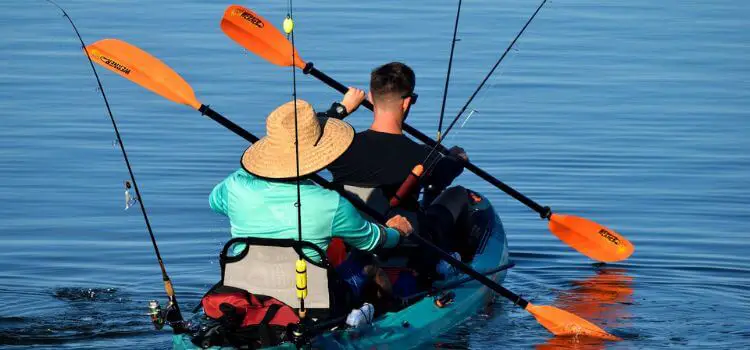As an Amazon Associates, I earn from quality purchases.
Are you an avid kayaker? Looking to push the limits of your adventures by carrying more gear? Or, are you embarking on longer expeditions? If so, understanding how to make a kayak hold more weight is essential.
Increasing the weight capacity of your kayak allows for added supplies and equipment. It also ensures better stability and maneuverability on the water.
In this comprehensive guide, we will explore practical tips and techniques to help you optimize your kayak’s weight capacity. Thus, ensuring you can confidently take on new challenges.
So, let’s dive in and discover how to make a kayak hold more weight while maintaining stability and performance.
Understanding Weight Capacity and Buoyancy

A. Explaining Weight Capacity and Its Significance in Kayaking:
When it comes to kayaking, weight capacity plays a crucial role in ensuring a safe and enjoyable experience on the water. The weight capacity of a kayak refers to the maximum amount of weight it can safely support without compromising stability and performance.
It takes into account not only the weight of the paddler but also any additional gear, equipment, and supplies that are being carried.
Choosing a kayak with an appropriate weight capacity is vital to maintain the balance of a kayak. It prevents the kayak from becoming unstable or difficult to maneuver.
Exceeding the recommended weight capacity can lead to decreased buoyancy. It can reduce maneuverability, and potentially even capsize the kayak.
Therefore, understanding and respecting the weight capacity of your kayak is essential for a safe and comfortable kayaking adventure.
B. Discussing the Concept of Buoyancy and Its Role in Supporting Weight:
Buoyancy is the force that enables an object to float in a liquid. It plays a significant role in supporting weight in a kayak. When it comes to kayaking, the buoyancy of the kayak affects its ability to stay afloat and carry weight efficiently.
Kayaks are designed with a specific shape and hull design. This design provides inherent buoyancy. The hull displaces water. It creates an upward force that counters the downward force of gravity acting on the kayak and its occupants.
This buoyant force allows the kayak to float and carry weight without sinking. Understanding the concept of buoyancy helps kayakers make informed decisions on how to enhance the weight capacity of their kayak.
Increasing Weight Capacity on a Kayak
A. Choosing the Right Kayak:
When aiming to increase the weight capacity of your kayak, it’s important to select a kayak that is designed to handle heavier loads. Consider the following:
Different Kayak Types and Designs:
Explore kayak types and designs specifically suited for increased weight capacity. Sit-on-top kayaks, for example, are known for their spaciousness and ability to accommodate more weight. Additionally, look for kayaks with higher weight ratings. They are engineered to handle heavier loads more effectively.
B. Distributing Weight Properly:

Importance of Proper Weight Distribution:
Proper weight distribution is essential for maximizing the weight capacity of your kayak and maintaining optimal stability. When weight is distributed evenly, it helps to keep the kayak balanced. It prevents the kayak from tilting or becoming unstable.
Uneven weight distribution can lead to a lopsided kayak. This can negatively impact its performance and increase the risk of capsizing.
Tips for Even Weight Distribution:
To ensure proper weight distribution in your kayak, consider the following tips:
Position Heavy Items Low and Centered:
Place heavier items, such as camping gear or coolers, in the central part of the kayak and closer to the hull. This helps to keep the center of gravity low, improving stability.
Avoid placing heavy items towards the ends of the kayak, as this can affect maneuverability and balance.
Balance Side-to-Side Weight:
Aim to distribute weight evenly from side to side. If you have heavy items on one side, counterbalance them with equivalent weight on the opposite side. This helps to maintain equilibrium and prevents the kayak from listing to one side.
Reduce Your Weight
Another way to increase your kayak’s weight capacity is to reduce your weight. Losing weight can be a difficult task. But even a small reduction in body weight can make a big difference in your kayak’s weight capacity.
C. Enhancing Buoyancy:
Enhancing the buoyancy of your kayak is key to improving its weight-carrying capabilities. Consider the following techniques:
Using Floatation Devices:
Floatation devices displace water and increase the kayak’s buoyancy. They allow the kayak to support more weight. They not only increase your kayak’s weight capacity but also make it more stable and easier to maneuver.
Modifying the Hull:
Explore options for modifying the kayak’s hull to enhance buoyancy. Adding bulkheads or extra compartments within the kayak can increase its overall floatation capacity.
Upgrading Materials:
Advanced composite materials or hybrid designs can contribute to improved weight capacity. It will also maintain structural integrity.
D. Paddle Location:
When it comes to loading your kayak to its maximum weight capacity or even exceeding it, the significance of considering your paddling location cannot be overstated. The choice of where you paddle can have a direct impact on the performance and safety of your kayak.
Let’s explore why paddling location matters about weight capacity and how it can affect your kayaking experience.
Impact of Water Conditions:
The type of water conditions you encounter while paddling plays a crucial role. When paddling in calm and still waters, the likelihood of water entering the cockpit of your kayak to a significant extent is reduced.
This helps in maintaining a dry and stable environment within the kayak, making it easier to handle and maneuver.
However, paddling in rough waters with continuous waves and turbulence can cause water to consistently enter the cockpit. It will result in the kayak being pushed lower into the water.
This increases the risk of capsizing, especially if the kayak is already loaded beyond its weight capacity.
Stability Considerations:
Paddling in rough waters or turbulent conditions while carrying excessive weight can compromise the stability of your kayak. The additional weight combined with the impact of waves or currents can make it challenging to maintain balance and control.
Choosing a paddling location with calmer waters, when possible, provides better stability. It reduces the risk of tipping or instability.
Saltwater vs. Freshwater:
If you find yourself in a situation where you have loaded your kayak beyond its recommended limit, paddling in saltwater can offer some advantages over freshwater. Saltwater has a higher density compared to freshwater. It provides greater buoyancy. It helps in keeping the kayak afloat despite the additional weight.
However, it is important to note that paddling with overloaded kayaks is not recommended regardless of the water type, as it can still compromise safety and performance.
Ensuring Kayak Stability

A. Reinforcing the Structure:
Importance of a Sturdy Kayak:
When it comes to increasing weight capacity and maintaining stability, having a sturdy kayak is paramount. A well-built and structurally sound kayak can handle additional weight more effectively. It reduces the risk of instability. It enhances overall performance on the water.
Reinforcement Techniques:
To reinforce the structure of your kayak, there are several techniques you can employ. Adding support bars or braces inside the kayak can provide additional rigidity. They minimize flexing and increase stability.
These reinforcements help distribute the weight more evenly. They reduce the chances of the kayak buckling or losing its shape when carrying heavier loads.
B. Proper Gear Storage:
Secure Storage:
Proper gear storage is crucial for maintaining stability. Ensure that your gear and equipment are securely fastened or stored in designated areas of the kayak.
Utilize bungee cords, deck bags, or storage compartments to secure your gear. They prevent it from shifting during paddling. This prevents any sudden weight shifts that could destabilize the kayak.
Tips for Stability:
Distribute the weight evenly throughout the kayak. It will enhance stability through proper gear storage. Place heavier items closer to the center and lower in the kayak. It helps to maintain a lower center of gravity and better balance.
Avoid overloading one side of the kayak, as this can cause it to tip. Regularly check and adjust the distribution of gear as needed during your kayaking trip to ensure optimal stability.
C. Improving Balance and Control:
Balanced Body Position:
Maintaining a balanced body position while paddling is essential for stability. Sit in an upright position with your weight evenly distributed between both hips. Avoid leaning excessively to one side, as this can destabilize the kayak. Engage your core muscles to maintain stability and control throughout your paddling strokes.
Techniques for Stability:
To enhance stability during turns and maneuvers, practice proper paddling techniques. Use a wider paddle stroke for increased stability. Engage your body by twisting from your torso rather than relying solely on your arms. Additionally, learn and practice corrective strokes, such as sweep strokes or bracing. It can help you regain stability in challenging situations.
Conclusion
Increasing your kayak’s weight capacity is possible with a few simple tips and tricks. It’s important to always check your kayak’s weight capacity and know your weight and the weight of your gear. Distributing weight evenly, using a kayak cart, and using dry bags can help increase your kayak’s weight capacity.
Additionally, considering a higher-capacity kayak or reducing your weight can also be effective. We encourage you, as readers, to implement these tips and techniques to enhance your kayak’s weight capacity and stability.
Remember, safety should always be a priority. So be sure to assess your kayaking skills and capabilities before attempting to carry heavier loads. Enjoy exploring new horizons and pushing the limits of your kayaking experiences with a well-prepared and optimized kayak!
Frequently Asked Questions (FAQs):
Q: Can I increase the weight capacity of my existing kayak?
Yes, it is possible to increase the weight capacity of your existing kayak to some extent. By implementing certain techniques, you can enhance its ability to carry more weight.
However, each kayak has its limits. Exceeding the manufacturer’s recommended weight capacity can compromise safety and performance.
Q: What are the benefits of using flotation devices to make a kayak hold more weight?
Using flotation devices, such as inflatable bags or foam inserts, can provide several benefits to increasing a kayak’s weight capacity. These devices displace water, increasing the overall buoyancy of the kayak and allowing it to support additional weight.
Q: What should I do if I exceed my kayak’s weight capacity?
Exceeding your kayak’s weight capacity can compromise your safety and stability on the water. If you find yourself exceeding the weight capacity of your kayak, consider removing non-essential gear or upgrading to a higher-capacity kayak.
Q: Are there specific kayak models designed for increased weight capacity?
Yes, there are specific kayak models designed with higher weight capacities to accommodate heavier loads. These kayaks are typically built with reinforced structures, wider hulls, or additional storage space to handle the increased weight.
Sit-on-top kayaks and certain touring or expedition kayaks are often known for their higher weight ratings.
Q: How can I distribute weight properly in my kayak to maintain stability while carrying more weight?
To distribute weight evenly in your kayak, pack heavier items closer to the center of the kayak and lighter items towards the ends. Additionally, consider using dry bags to keep gear organized and prevent shifting while paddling.
You may also read: How Heavy Is a Kayak?

Leave a Reply